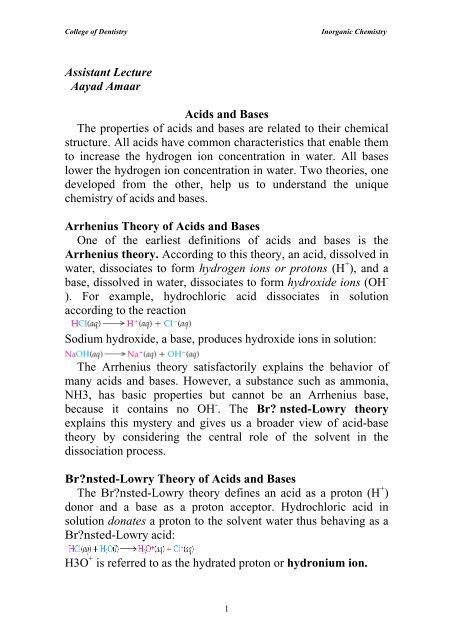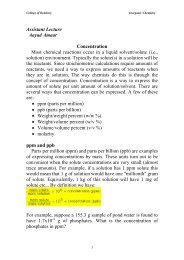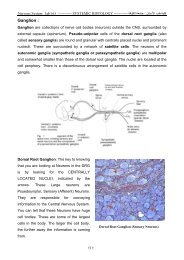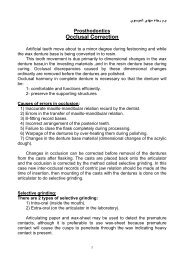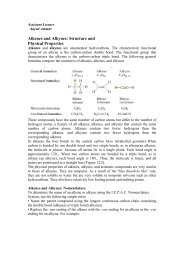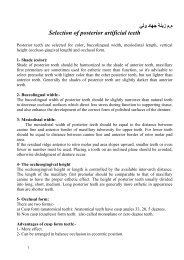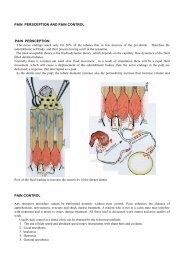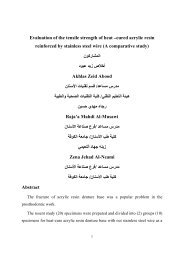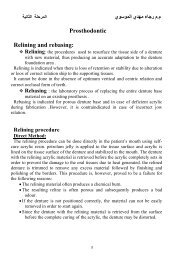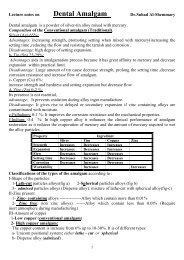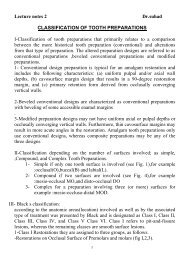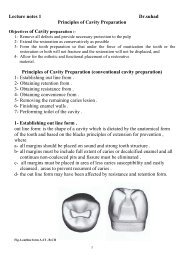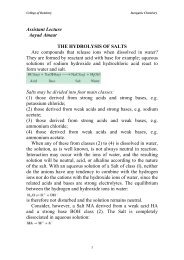Assistant Lecture Aayad Amaar Acids and Bases The properties of ...
Assistant Lecture Aayad Amaar Acids and Bases The properties of ...
Assistant Lecture Aayad Amaar Acids and Bases The properties of ...
You also want an ePaper? Increase the reach of your titles
YUMPU automatically turns print PDFs into web optimized ePapers that Google loves.
College <strong>of</strong> Dentistry<br />
Inorganic Chemistry<br />
<strong>Assistant</strong> <strong>Lecture</strong><br />
<strong>Aayad</strong> <strong>Amaar</strong><br />
<strong>Acids</strong> <strong>and</strong> <strong>Bases</strong><br />
<strong>The</strong> <strong>properties</strong> <strong>of</strong> acids <strong>and</strong> bases are related to their chemical<br />
structure. All acids have common characteristics that enable them<br />
to increase the hydrogen ion concentration in water. All bases<br />
lower the hydrogen ion concentration in water. Two theories, one<br />
developed from the other, help us to underst<strong>and</strong> the unique<br />
chemistry <strong>of</strong> acids <strong>and</strong> bases.<br />
Arrhenius <strong>The</strong>ory <strong>of</strong> <strong>Acids</strong> <strong>and</strong> <strong>Bases</strong><br />
One <strong>of</strong> the earliest definitions <strong>of</strong> acids <strong>and</strong> bases is the<br />
Arrhenius theory. According to this theory, an acid, dissolved in<br />
water, dissociates to form hydrogen ions or protons (H + ), <strong>and</strong> a<br />
base, dissolved in water, dissociates to form hydroxide ions (OH -<br />
). For example, hydrochloric acid dissociates in solution<br />
according to the reaction<br />
Sodium hydroxide, a base, produces hydroxide ions in solution:<br />
<strong>The</strong> Arrhenius theory satisfactorily explains the behavior <strong>of</strong><br />
many acids <strong>and</strong> bases. However, a substance such as ammonia,<br />
NH3, has basic <strong>properties</strong> but cannot be an Arrhenius base,<br />
because it contains no OH - . <strong>The</strong> Br? nsted-Lowry theory<br />
explains this mystery <strong>and</strong> gives us a broader view <strong>of</strong> acid-base<br />
theory by considering the central role <strong>of</strong> the solvent in the<br />
dissociation process.<br />
Br?nsted-Lowry <strong>The</strong>ory <strong>of</strong> <strong>Acids</strong> <strong>and</strong> <strong>Bases</strong><br />
<strong>The</strong> Br?nsted-Lowry theory defines an acid as a proton (H + )<br />
donor <strong>and</strong> a base as a proton acceptor. Hydrochloric acid in<br />
solution donates a proton to the solvent water thus behaving as a<br />
Br?nsted-Lowry acid:<br />
H3O + is referred to as the hydrated proton or hydronium ion.
College <strong>of</strong> Dentistry<br />
Inorganic Chemistry<br />
<strong>The</strong> basic <strong>properties</strong> <strong>of</strong> ammonia are clearly accounted for by<br />
the Br?nsted-Lowry theory. Ammonia accepts a proton from the<br />
solvent water, producing OH - . An equilibrium mixture <strong>of</strong> NH3,<br />
H2O, NH4 + , <strong>and</strong> OH - results.<br />
For aqueous solutions, the Br?nsted-Lowry theory adequately<br />
describes the behavior <strong>of</strong> acids <strong>and</strong> bases. We shall limit our<br />
discussion <strong>of</strong> acid-base chemistry to aqueous solutions <strong>and</strong> use<br />
the following definitions:<br />
An acid is a proton donor.<br />
A base is a proton acceptor.<br />
Conjugate <strong>Acids</strong> <strong>and</strong> <strong>Bases</strong><br />
<strong>The</strong> Br?nsted-Lowry theory contributed several fundamental<br />
ideas that broadened our underst<strong>and</strong>ing <strong>of</strong> solution chemistry.<br />
First <strong>of</strong> all, an acid-base reaction is a charge-transfer process.<br />
Second, the transfer process usually involves the solvent. Water<br />
may, in fact, accept or donate a proton. Last, <strong>and</strong> perhaps most<br />
important, the acid-base reaction is seen as a reversible process.<br />
Consequently, any acid-base reaction can be represented by the<br />
general equation<br />
In the forward reaction, the acid (HA) donates a proton (H + ) to the<br />
base (B) leading to the formation <strong>of</strong> BH + <strong>and</strong> A - . However, in the<br />
reverse reaction, it is the BH + that behaves as an acid; it donates<br />
its extra proton to A - . A - is therefore a base in its own right<br />
because it accepts the proton. <strong>The</strong>se product acids <strong>and</strong> bases are<br />
termed conjugate acids <strong>and</strong> bases.<br />
A conjugate acid is the species formed when a base accepts<br />
a proton.<br />
A conjugate base is the species formed when an acid<br />
donates a proton.
College <strong>of</strong> Dentistry<br />
Inorganic Chemistry<br />
<strong>The</strong> acid <strong>and</strong> base on the opposite sides <strong>of</strong> the equation are<br />
collectively termed a conjugate acid-base pair. In the above<br />
equation:<br />
BH + is the conjugate acid <strong>of</strong> the base B.<br />
A - is the conjugate base <strong>of</strong> the acid HA.<br />
B <strong>and</strong> BH + constitute a conjugate acid-base pair.<br />
HA <strong>and</strong> A - constitute a conjugate acid-base pair.<br />
Rewriting our model equation:<br />
Although we show the forward <strong>and</strong> reverse arrows to indicate<br />
the reversibility <strong>of</strong> the reaction, seldom are the two processes<br />
equal but opposite. One reaction, either forward or reverse, is<br />
usually favored. Consider the reaction <strong>of</strong> hydrochloric acid in<br />
water:<br />
HCl is a much better proton donor than H 3 O + . Consequently the<br />
forward reaction predominates, the reverse reaction is<br />
inconsequential, <strong>and</strong> hydrochloric acid is termed a strong acid.<br />
<strong>The</strong> dissociation <strong>of</strong> hydrochloric acid is so favorable that we<br />
describe it as 100% dissociated <strong>and</strong> use only a single forward<br />
arrow to represent its behavior in water:<br />
<strong>The</strong> degree <strong>of</strong> dissociation, or strength, <strong>of</strong> acids <strong>and</strong> bases has a<br />
pr<strong>of</strong>ound influence on their aqueous chemistry. For example,<br />
vinegar (a 5% [w/v] solution <strong>of</strong> acetic acid in water) is a<br />
consumable product; aqueous hydrochloric acid in water is not.<br />
Why? Acetic acid is a weak acid <strong>and</strong>, as a result, a dilute solution<br />
does no damage to the mouth <strong>and</strong> esophagus. <strong>The</strong> following<br />
section looks at the strength <strong>of</strong> acids <strong>and</strong> bases in solution in more<br />
detail.
College <strong>of</strong> Dentistry<br />
Inorganic Chemistry<br />
Acid-Base Properties <strong>of</strong> Water<br />
<strong>The</strong> role that the solvent, water, plays in acid-base reactions is<br />
noteworthy. In the example above, the water molecule accepts a<br />
proton from the HCl molecule. <strong>The</strong> water is behaving as a proton<br />
acceptor, a base. However, when water is a solvent for ammonia<br />
(NH 3 ), a base, the water molecule donates a proton to the<br />
ammonia molecule. <strong>The</strong> water, in this situation, is acting as a<br />
proton donor, an acid. Water, owing to the fact that it possesses<br />
both acid <strong>and</strong> base <strong>properties</strong>, is termed amphiprotic. <strong>The</strong><br />
solvent <strong>properties</strong> <strong>of</strong> water are a consequence <strong>of</strong> this ability to<br />
either accept or donate protons. Water is the most commonly used<br />
solvent for acids <strong>and</strong> bases. <strong>The</strong>se interactions promote solubility<br />
<strong>and</strong> dissociation <strong>of</strong> acids <strong>and</strong> bases<br />
Acid <strong>and</strong> Base Strength<br />
<strong>The</strong> terms acid or base strength <strong>and</strong> acid or base concentration<br />
are easily confused. Strength is a measure <strong>of</strong> the degree <strong>of</strong><br />
dissociation <strong>of</strong> an acid or base in solution, independent <strong>of</strong> its<br />
concentration. Concentration, as we have learned, refers to the<br />
amount <strong>of</strong> solute (in this case, the amount <strong>of</strong> acid or base) per<br />
quantity <strong>of</strong> solution. <strong>The</strong> strength <strong>of</strong> acids <strong>and</strong> bases in water<br />
depends on the extent to which they react with the solvent, water.<br />
<strong>Acids</strong> <strong>and</strong> bases are classified as strong when the reaction with<br />
water is virtually 100% complete <strong>and</strong> as weak when the reaction<br />
with water is much less than 100% complete.<br />
Important strong acids include:<br />
Note that the equation for the dissociation <strong>of</strong> each <strong>of</strong> these<br />
acids is written with a single arrow. This indicates that the<br />
reaction has little or no tendency to proceed in the reverse<br />
direction to establish equilibrium. All <strong>of</strong> the acid molecules are<br />
dissociated to form ions.<br />
All common strong bases are metal hydroxides. Strong bases<br />
completely dissociate in aqueous solution to produce hydroxide
College <strong>of</strong> Dentistry<br />
Inorganic Chemistry<br />
ions <strong>and</strong> metal cations. Of the common metal hydroxides, only<br />
NaOH <strong>and</strong> KOH are soluble in water <strong>and</strong> are readily usable strong<br />
bases:<br />
Weak acids <strong>and</strong> weak bases dissolve in water principally in the<br />
molecular form. Only a small percentage <strong>of</strong> the molecules<br />
dissociate to form the hydronium or hydroxide ion.<br />
Two important weak acids are:<br />
<strong>The</strong> double arrow implies an equilibrium between dissociated<br />
<strong>and</strong> undissociated species. We have already mentioned the most<br />
common weak base, ammonia. Many organic compounds<br />
function as weak bases. Several examples <strong>of</strong> weak bases follow:<br />
<strong>The</strong> fundamental chemical difference between strong <strong>and</strong> weak<br />
acids or bases is their equilibrium ion concentration. A strong<br />
acid, such as HCl, does not, in aqueous solution, exist to any<br />
measurable degree in equilibrium with its ions, H 3 O + <strong>and</strong> Cl - . On<br />
the other h<strong>and</strong>, a weak acid, such as acetic acid, establishes a<br />
dynamic equilibrium with its ions, H 3 O + <strong>and</strong> CH3COO - . <strong>The</strong><br />
relative strength <strong>of</strong> an acid or base is determined by the ease with<br />
which it donates or accepts a proton. <strong>Acids</strong> with the greatest<br />
proton-donating capability (strongest acids) have the weakest<br />
conjugate bases. Good proton acceptors (strong bases) have weak<br />
conjugate acids.<br />
Solutions <strong>of</strong> acids <strong>and</strong> bases used in the laboratory must be<br />
h<strong>and</strong>led with care. <strong>Acids</strong> burn because <strong>of</strong> their exothermic<br />
reaction with water present on <strong>and</strong> in the skin. <strong>Bases</strong> react with<br />
proteins, which are principal components <strong>of</strong> the skin <strong>and</strong> eyes.<br />
Such solutions are more hazardous if they are strong or<br />
concentrated. A strong acid or base produces more H3O + or OH -<br />
than does the corresponding weak acid or base. More-
College <strong>of</strong> Dentistry<br />
Inorganic Chemistry<br />
concentrated acids or bases contain more H 3 O + or OH - than do<br />
less concentrated solutions <strong>of</strong> the same strength.<br />
<strong>The</strong> Dissociation <strong>of</strong> Water<br />
Aqueous solutions <strong>of</strong> acids <strong>and</strong> bases are electrolytes. <strong>The</strong><br />
dissociation <strong>of</strong> the acid or base produces ions that can conduct an<br />
electrical current. As a result <strong>of</strong> the differences in the degree <strong>of</strong><br />
dissociation, strong acids <strong>and</strong> bases are strong electrolytes; weak<br />
acids <strong>and</strong> bases are weak electrolytes. <strong>The</strong> conductivity <strong>of</strong> these<br />
solutions is principally dependent on the solute <strong>and</strong> not the<br />
solvent (water).<br />
Although pure water is virtually 100% molecular, a small number<br />
<strong>of</strong> water molecules do ionize. This process occurs by the transfer<br />
<strong>of</strong> a proton from one water molecule to another, producing a<br />
hydronium ion <strong>and</strong> a hydroxide ion:<br />
This process is the autoionization, or self-ionization, <strong>of</strong> water.<br />
Water is therefore a very weak electrolyte <strong>and</strong> a very poor<br />
conductor <strong>of</strong> electricity. Water has both acid <strong>and</strong> base <strong>properties</strong>;<br />
dissociation produces both the hydronium <strong>and</strong> hydroxide ion.<br />
Pure water at room temperature has a hydronium ion<br />
concentration <strong>of</strong> 1.0x10 -7 M. One hydroxide ion is produced for<br />
each hydronium ion. <strong>The</strong>refore, the hydroxide ion concentration<br />
is also 1.0x10 -7 M. Molar equilibrium concentration is<br />
conveniently indicated by brackets around the species whose<br />
concentration is represented:<br />
<strong>The</strong> product <strong>of</strong> hydronium <strong>and</strong> hydroxide ion concentration in<br />
pure water is referred to as the ion product for water.<br />
<strong>The</strong> ion product is constant because its value does not depend on<br />
the nature or concentration <strong>of</strong> the solute, as long as the<br />
temperature does not change. <strong>The</strong> ion product is a temperature-
College <strong>of</strong> Dentistry<br />
Inorganic Chemistry<br />
dependent quantity. <strong>The</strong> nature <strong>and</strong> concentration <strong>of</strong> the solutes<br />
added to water do alter the relative concentrations <strong>of</strong> H 3 O + <strong>and</strong><br />
OH - present, but the product, [H 3 O + ][OH - ], always equals 1.0x10 -<br />
14<br />
at 25 °C. This relationship is the basis for a scale that is useful<br />
in the measurement <strong>of</strong> the level <strong>of</strong> acidity or basicity <strong>of</strong> solutions.<br />
This scale, the pH scale.
This document was created with Win2PDF available at http://www.daneprairie.com.<br />
<strong>The</strong> unregistered version <strong>of</strong> Win2PDF is for evaluation or non-commercial use only.


